|
|
|
|
|---|---|---|
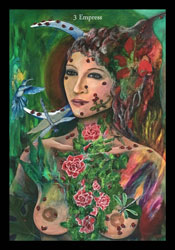
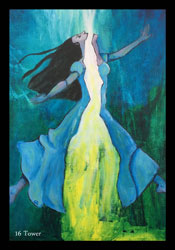
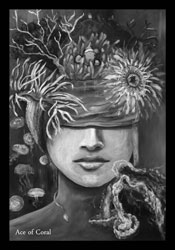
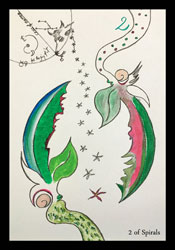
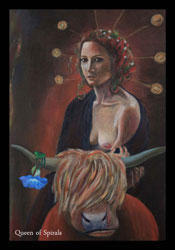
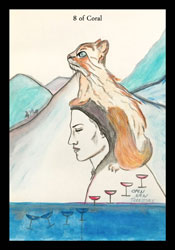
|
Transformational Tarot
deck creator Arnell Ando has begun to curate/publish some phenomenal decks, and I use the word phenomenal as a double entendre. Previously, Ando focused on the work of
Ellen Lorenzi-Prince,
but the collection has been expanded to include the work of another woman artist with a unique vision and style:
Carmen Sorrenti.
If you are like me, you’d like to begin by understanding what the name of the deck means. The word Pholarchos has only been found in inscriptions at Velia, an ancient Greek city circa 538 B.C. It combines the word “archos” — a master or chief—and “pholeos”—a cave or lair. It’s a place of the numinous: dreams, retreat, suspended animation. Without knowing the meaning of the title, viewing the deck would be its own form of hoodwinking, because trying to understand this deck is impossible without accepting its thematic form; they are uniquely and utterly intertwined. Once you have completely grokked that this is a liminal deck, one where every card is its own nucleus of this dream state, you are better able to meet it on its own, very individual, terms. Sorrenti, an artist of many media, including poetry, paint, and drawing, has created a Major Arcana of paintings that will soon be exhibited at a number of American and European galleries. (I am hoping to travel to the one in New York City.) Some are similar enough to our personal internal tarot galleries to be immediately assimilated, but others require thought and study. Let’s begin with the familiar, but still unknown. The Empress is not earthy, she is earth, a bounty of flesh, flowers, and leaves of pure emerald. You have always known her, you have always worshipped Her. The Emperor, her primal consort, is even more recognizable; his blue-skinned, flat visage radiates power, his body, boundaries. The Tower shows a woman rent in two by white lightning of the stormy, non-alcoholic kind—she is forever changed, riven, irrevocably enlightened. You are, too, when you look upon her—you will never glimpse another Tower card without feeling rocked as well. But there are a number of paintings that fit less comfortably within our archetypal tarot template. The Hermit shows a glowing white being embracing the head of a Black man wreathed in fluffy white curls. An Australian querent saw him as Aboriginal. The Moon depicts an ethereal dancer with a gauze halo wrap is planted in front of a circular labyrinth. Even after reading the description and studying the image, I haven’t quite absorbed The World: a woman in red, a tree at her center, stands next to a draped figure, against a milky circle. In order to emphasize that the Aces and Knights (renamed “Trail” in the Pholarchos Tarot) are specifical portals to the dream cave, they are black and white versions of the paintings—if you get the chance to look at the originals on Sorrenti’s site, do so. I earlier referred to “hoodwinking”— that was a bit of an in-joke. Each Ace has a sole blindfolded figure, and “hoodwinking” is the word Sorrenti uses for blindfolding. It forces us to use another sight, an internal sight, rather than the one on which we traditionally rely. The court cards are each lovely in their own way. The winsome Trail of Sparks reminds me of Audrey Hepburn in “My Fair Lady,” her hair its own intricate Ascot hat, if Eliza had brought her companion animal to the races. The Minor Arcana are equally eccentric: the early cards in the suit are sketches, some dotted with alchemical and astrological symbols, mid-and-later cards are more refined drawings, and the last card is an acrylic painting, showing a specific suit progression. The exception is the Ten of Spirals—I’m not sure why. The drawings are always interesting and often captivating. The Two of Spirals depicts two falling leaves, each a wish, both in flow. The Seven of Spirals, a card that can indicate someone anxious for a nurtured plant to flower or one who wants to reap without the effort of nurturing is blown to bits and also both fully encompassed in an image of a tree fully-embraced by and connected to a red-haired, leaf-bedecked figure, frog-in-hand. It’s not only the emerald green that heralds this card’s connection to the Empress, and it’s a connection I’ll remember. The artist usually uses colors we consider traditional to the suits, but the Queen of Spirals, with her auburn hair and maned animal makes me think of Fire, not Earth. In keeping with this thematic readjustment, the suits have been renamed to reflect elemental symbols: Wands are Sparks; Cups, Coral; Swords are Wings, and Pentacles, Spirals. The card descriptions are very poetic and often help to meld traditional meanings with the more untraditional artwork. I found it helpful to go through each card with the companion booklet, and especially advantageous to describe the card for myself before reading the matching card description. Often I easily aligned my understanding of the Pholarchos rendition with typical interpretations, which made me more willing to stretch my understanding when I didn’t. I recommend this practice for those who plan to read with this deck. One thing I need to note: sometimes the artist will describe something going on imagistically that does not actually appear in the card. One example (of several) is the Dreamer of Sparks, wherein two lifeless puppets are described, yet I do not see them in the image (and I looked). Perhaps this is a trick of the Pholarchos’ cave light. As a tarot reviewer, my bottom line is always, always: how do the cards read. Because the booklet and art are so focused on the spiritual, I thought to limit my readings to the most profound metaphysical subjects. And, indeed, they spoke to karmic lessons and provided deep insights. But they were also potently, insistently predictive and pragmatic. One woman wanted to know if she were cursed and needed to move and I initially hesitated to read something so relatively mundane. The cards were the Eight of Coral (Cups) and the Six of Wings (Swords), perhaps the two cards most specifically predictive on the subject of departure. I am well used to the Tarot being shockingly precise and definitive, yet this reading was akin to a scalpel-blow. When it comes to reading Tarot, I love scalpel-blow-type readings. Even so, I plan to use this deck solely for wisdom readings. It can be used for any topic, but it is built for profundity. If you are looking for a potent, beautiful deck that will stretch you, but not confound you to the point of anger, the Pholarchos Tarot is, pardon the double entendre, your dream Tarot. It does force you to enter into a dimly lit cave and suspend much (but not nearly all) of your encrusted tarot template. If you are willing to engage with it, you can glimpse scenes of a previously invisible night sky, illuminated by wild shooting stars in vibrant, shimmering colors, with pathways you can explore until they become your very own. Your tarot library will be broadened and expanded; so will you.
Review by Diane Wilkes: Creator of the annual Northeastern Tarot Conclave and author of Tarot of Jane Austen, published by Lo Scarabeo, and Web Mistress of legendary Tarot site Tarot Passages. |
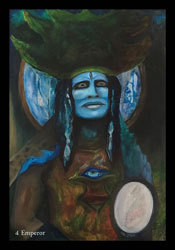
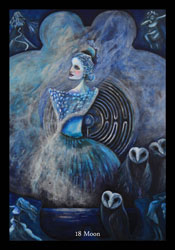
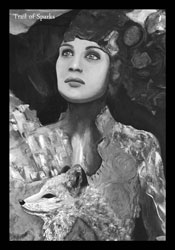
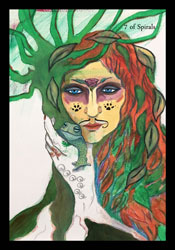
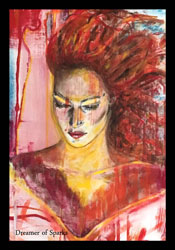
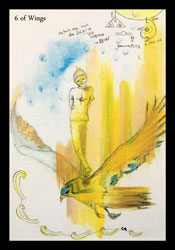
|
|
|
Pholarchos Tarot is copyright protected. Card images may be used on blogs/websites as 'Card of the Day' endeavors or for review purposes but must contain artist's site along with Pholarchos Tarot by Carmen Sorrenti. The images are not to form part of written teaching material or otherwise be used without prior consent from artist, Carmen Sorrenti. |
|
|
|
This site designed & maintained by Arnell's Art |